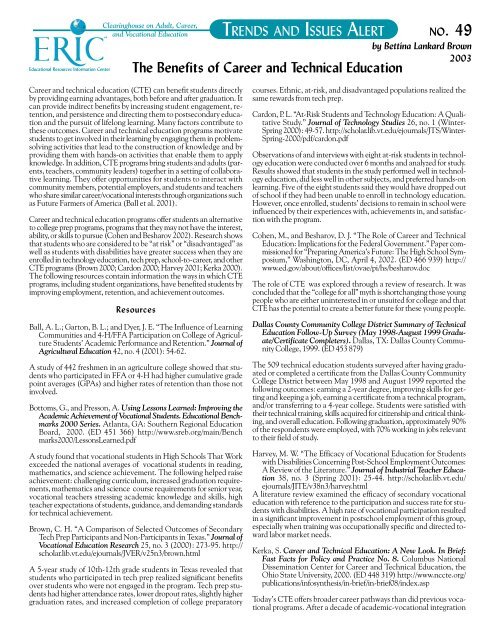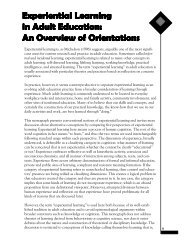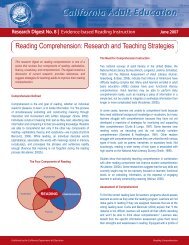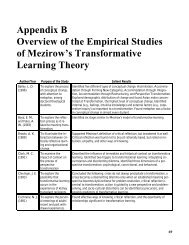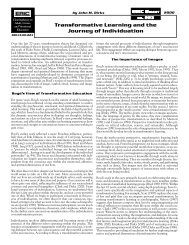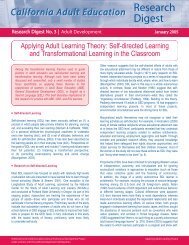PDF Available - CALPRO
PDF Available - CALPRO
PDF Available - CALPRO
- No tags were found...
Create successful ePaper yourself
Turn your PDF publications into a flip-book with our unique Google optimized e-Paper software.
Educational Resources Information CenterClearinghouse on Adult, Career,and Vocational EducationTRENDS AND ISSUES ALERTThe Benefits of Career and Technical EducationNO. 49by Bettina Lankard Brown2003Career and technical education (CTE) can benefit students directlyby providing earning advantages, both before and after graduation. Itcan provide indirect benefits by increasing student engagement, retention,and persistence and directing them to postsecondary educationand the pursuit of lifelong learning. Many factors contribute tothese outcomes. Career and technical education programs motivatestudents to get involved in their learning by engaging them in problemsolvingactivities that lead to the construction of knowledge and byproviding them with hands-on activities that enable them to applyknowledge. In addition, CTE programs bring students and adults (parents,teachers, community leaders) together in a setting of collaborativelearning. They offer opportunities for students to interact withcommunity members, potential employers, and students and teacherswho share similar career/vocational interests through organizations suchas Future Farmers of America (Ball et al. 2001).Career and technical education programs offer students an alternativeto college prep programs, programs that they may not have the interest,ability, or skills to pursue (Cohen and Besharov 2002). Research showsthat students who are considered to be “at risk” or “disadvantaged” aswell as students with disabilities have greater success when they areenrolled in technology education, tech prep, school-to-career, and otherCTE programs (Brown 2000; Cardon 2000; Harvey 2001; Kerka 2000).The following resources contain information the ways in which CTEprograms, including student organizations, have benefited students byimproving employment, retention, and achievement outcomes.ResourcesBall, A. L.; Garton, B. L.; and Dyer, J. E. “The Influence of LearningCommunities and 4-H/FFA Participation on College of AgricultureStudents’ Academic Performance and Retention.” Journal ofAgricultural Education 42, no. 4 (2001): 54-62.A study of 442 freshmen in an agriculture college showed that studentswho participated in FFA or 4-H had higher cumulative gradepoint averages (GPAs) and higher rates of retention than those notinvolved.Bottoms, G., and Presson, A. Using Lessons Learned: Improving theAcademic Achievement of Vocational Students. Educational Benchmarks2000 Series. Atlanta, GA: Southern Regional EducationBoard, 2000. (ED 451 366) http://www.sreb.org/main/Benchmarks2000/LessonsLearned.pdfA study found that vocational students in High Schools That Workexceeded the national averages of vocational students in reading,mathematics, and science achievement. The following helped raiseachievement: challenging curriculum, increased graduation requirements,mathematics and science course requirements for senior year,vocational teachers stressing academic knowledge and skills, highteacher expectations of students, guidance, and demanding standardsfor technical achievement.Brown, C. H. “A Comparison of Selected Outcomes of SecondaryTech Prep Participants and Non-Participants in Texas.” Journal ofVocational Education Research 25, no. 3 (2000): 273-95. http://scholar.lib.vt.edu/ejournals/JVER/v25n3/brown.htmlA 5-year study of 10th-12th grade students in Texas revealed thatstudents who participated in tech prep realized significant benefitsover students who were not engaged in the program. Tech prep studentshad higher attendance rates, lower dropout rates, slightly highergraduation rates, and increased completion of college preparatorycourses. Ethnic, at-risk, and disadvantaged populations realized thesame rewards from tech prep.Cardon, P. L. “At-Risk Students and Technology Education: A QualitativeStudy.” Journal of Technology Studies 26, no. 1 (Winter-Spring 2000): 49-57. http://scholar.lib.vt.edu/ejournals/JTS/Winter-Spring-2000/pdf/cardon.pdfObservations of and interviews with eight at-risk students in technologyeducation were conducted over 6 months and analyzed for study.Results showed that students in the study performed well in technologyeducation, did less well in other subjects, and preferred hands-onlearning. Five of the eight students said they would have dropped outof school if they had been unable to enroll in technology education.However, once enrolled, students’ decisions to remain in school wereinfluenced by their experiences with, achievements in, and satisfactionwith the program.Cohen, M., and Besharov, D. J. “The Role of Career and TechnicalEducation: Implications for the Federal Government.” Paper commissionedfor “Preparing America’s Future: The High School Symposium,”Washington, DC, April 4, 2002. (ED 466 939) http://www.ed.gov/about/offices/list/ovae/pi/hs/besharov.docThe role of CTE was explored through a review of research. It wasconcluded that the “college for all” myth is shortchanging those youngpeople who are either uninterested in or unsuited for college and thatCTE has the potential to create a better future for these young people.Dallas County Community College District Summary of TechnicalEducation Follow-Up Survey (May 1998-August 1999 Graduate/CertificateCompleters). Dallas, TX: Dallas County CommunityCollege, 1999. (ED 453 879)The 509 technical education students surveyed after having graduatedor completed a certificate from the Dallas County CommunityCollege District between May 1998 and August 1999 reported thefollowing outcomes: earning a 2-year degree, improving skills for gettingand keeping a job, earning a certificate from a technical program,and/or transferring to a 4-year college. Students were satisfied withtheir technical training, skills acquired for citizenship and critical thinking,and overall education. Following graduation, approximately 90%of the respondents were employed, with 70% working in jobs relevantto their field of study.Harvey, M. W. “The Efficacy of Vocational Education for Studentswith Disabilities Concerning Post-School Employment Outcomes:A Review of the Literature.” Journal of Industrial Teacher Education38, no. 3 (Spring 2001): 25-44. http://scholar.lib.vt.edu/ejournals/JITE/v38n3/harvey.htmlA literature review examined the efficacy of secondary vocationaleducation with reference to the participation and success rate for studentswith disabilities. A high rate of vocational participation resultedin a significant improvement in postschool employment of this group,especially when training was occupationally specific and directed towardlabor market needs.Kerka, S. Career and Technical Education: A New Look. In Brief:Fast Facts for Policy and Practice No. 8. Columbus NationalDissemination Center for Career and Technical Education, theOhio State University, 2000. (ED 448 319) http://www.nccte.org/publications/infosynthesis/in-brief/in-brief08/index.aspToday’s CTE offers broader career pathways than did previous vocationalprograms. After a decade of academic-vocational integration
and tech prep, it is recognized that school-to-career programs are aboutemphasizing a dual career path that leaves the option of college openwhile providing students with marketable skills. Workplace changeshave made technical employment the fastest-growing sector of thelabor market. The increasing opportunities and salaries associated withtechnical occupations have changed the demographics of today’s CTEstudents who are often in the top 5% of their high school classes.Johnson, A. B.; McDonald, D.; and MacAllum, K. The Lansing AreaManufacturing Partnership: A School-to-Success Story. Washington,DC: National Institute for Work and Learning, Academyfor Educational Development, 2002. (ED 462 628) http://www.aed.org/aedgroups/eduworkforce/ctrniwl/publications/LAMPSuccess.pdfBenefits of the Lansing Area Manufacturing Partnership (LAMP) programincluded work-based and project-based learning, team teaching,and opportunities for close interaction between staff, high school seniors,and employers. The study documented that, in the short term,participation in LAMP contributes to students’ personal growth, enhancestheir employability skills, and improves their preparedness tomake education and career decisions.MacAllum, K., and Bozick, R. “What Happens after They Graduate?Results from a Longitudinal Study of STC Graduates.” Paper presentedat the annual convention of the Association for Career andTechnical Education, New Orleans, LA, December 13-16, 2001.(ED 462 598)Data collected from a study of students involved in the LAMP program,an academically rigorous business/labor-driven school-to-careerprogram in Lansing, Michigan, showed that LAMP graduates hadhigher postsecondary enrollment than nonparticipants, higher GPAs,and higher hourly wages following graduation. LAMP appeared toprepare students better for the challenges and responsibilities of work,leading them to pursue career-enhancing opportunities at higher ratesthan nonparticipants.Miller, K., and Meuleners, M. “Straight from the Source.” Techniques:Connecting Education and Careers 75, no. 1 (January 2000): 24-25.Two CTE students discuss the benefits of participation, citing studentorganizations and teacher involvement as factors that helped themlearn new skills, prepare for change, and develop positive attitudestoward an ever-changing workplace.National Centre for Vocational Education Research. TAFE Graduates:Do They Get What They Want from Training? Statistics2001. At a Glance. Leabrook, Australia: NCVER, May 2002. (ED465 897) http://www.ncver.edu.au/statistics/aag/tafe_want01/tafe_want.pdfAn analysis of data from the 2001 Student Outcomes Survey, whichexamined the progress of students who graduated from Australia’stechnical and further education (TAFE) programs showed that theemployment rate for apprentices/trainees and labor market entrantsincreased from 51% in work before TAFE training to 71% in workafterward. Approximately 90% of students who sought to improve theirskills through TAFE training were employed before and after theirtraining.Ryan, C. Individual Returns to Vocational Education and TrainingQualifications: Their Implications for Lifelong Learning. Leabrook,Australia: National Centre for Vocational Education Research,2002a. (ED 463 451) http://www.ncver.edu.au/research/proj/nr0019.pdfData from Australia’s 1997 Survey of Education and Training showedthat individuals who complete vocational education and training(VET) qualifications generally receive higher wages than similar individualswho do not complete VET, although wages vary by VET qualificationlevel.Ryan, C. What Are the Longer-Term Outcomes for Individuals CompletingVocational Education and Training Qualifications? Leabrook,Australia: National Centre for Vocational EducationResearch, 2002b. (ED 463 451) http://www.ncver.edu.au/research/proj/nr0020.pdfA study conducted by the Australian Bureau of Statistics showed thatcompleting VET qualifications improved graduates’ full-time employmentoutcomes. However, male graduates realized more immediateand substantial benefits from completion of their qualifications thandid female graduates.Sanchez, J. R., and Laanan, F. S. “The Economic Returns of a CommunityCollege Education. ERIC Review.” Community College Review25, no. 3 (Winter 1997): 73-87.The results of studies from several states show that all reporting ethnicgroups of vocational students who graduated from community collegesrealized positive gains in earnings within 3 years of graduation.“The Earning Potential of Career and Technical Education.” Techniques:Connecting Education and Careers 76, no. 6 (September2001): 24.A follow-up study of students graduating from the University of Wisconsinand the Milwaukee Area Technical College from 1993-1998confirms the benefits in potential earnings of career and technicaleducation. Students who upgraded their skills and received anassociate’s degree increased their earnings by 9 percent more thanstudents who graduated with only a high school diploma and continueto be positioned to achieve higher salaries in subsequent years.Wisconsin Technical College System Board 2002-2001 GraduateFollow-Up Report. Madison: Wisconsin Technical College SystemBoard, April 2002. http://www.board.tec.wi.us/Publications/GraduateFollow-up/default.htmA report on the 2001 graduate follow-up survey revealed that 97% ofthe respondents were satisfied or very satisfied with their training and80% of them were employed in jobs related to their programs. Approximatelyone-third of the respondents were 20-24 years of age and enrolledin health-related business or industrial service programs. Fortyfourpercent of the respondents were attending technical college inpreparation for employment.Wonacott, M. E. Benefits of Vocational Education. Myths and RealitiesNo. 8. Columbus: ERIC Clearinghouse on Adult, Career, andVocational Education, the Ohio State University, 2000. (ED 441179) http://www.ericacve.org/mr.aspAlthough many people have associated vocational education withnoncollege bound, at-risk, or special needs students, new career/technical/vocationalprograms attract a wide range of students, preparingthem with skills that increase worker productivity, skill transfer, jobaccess, and job stability. Eighty percent of high school students take atleast one occupationally specific vocational course and one in eightacademic students takes more vocational courses than do vocationalstudents.This project has been funded at least in part with Federal funds from the U.S. Departmentof Education under Contract No. ED-99-CO-0013. The content of thispublication does not necessarily reflect the views or policies of the U.S. Departmentof Education nor does mention of trade names, commercial products, or organizationsimply endorsement by the U.S. Government. Trends and Issues Alerts may befreely reproduced and are available at .


